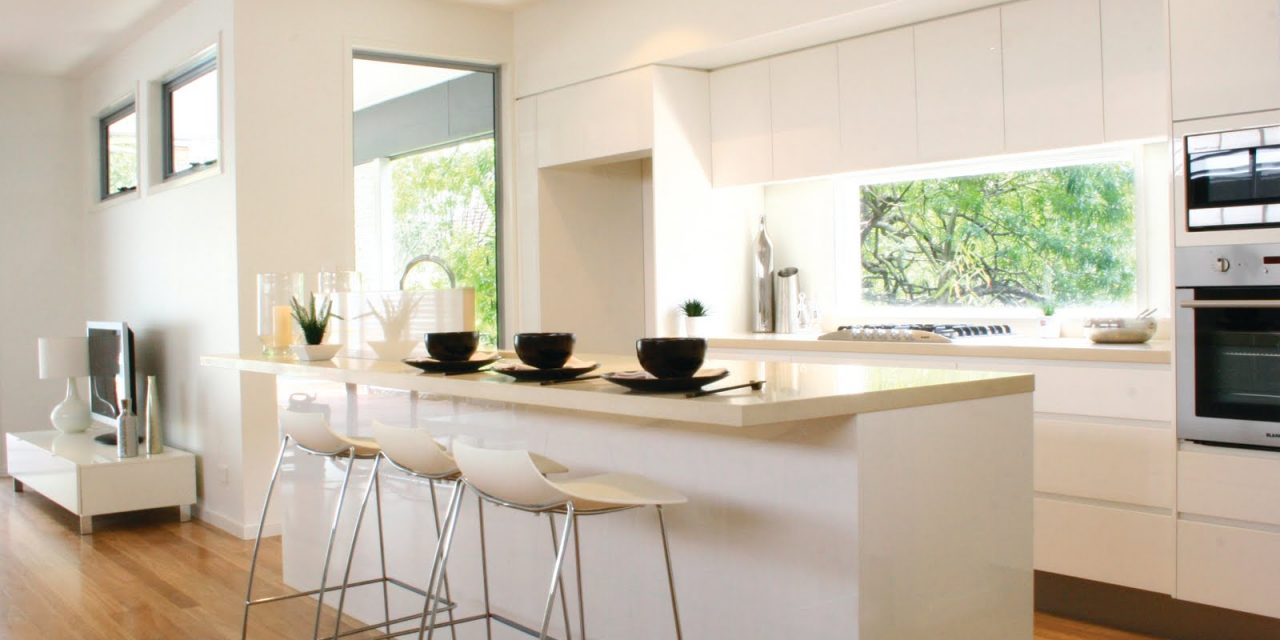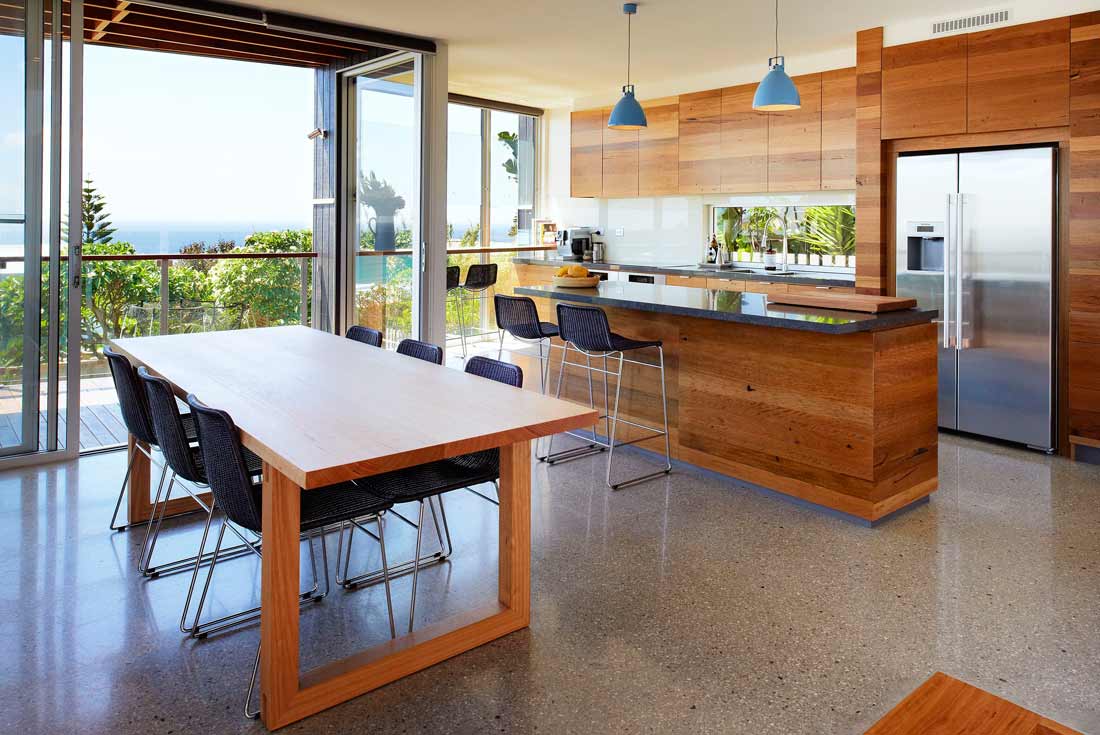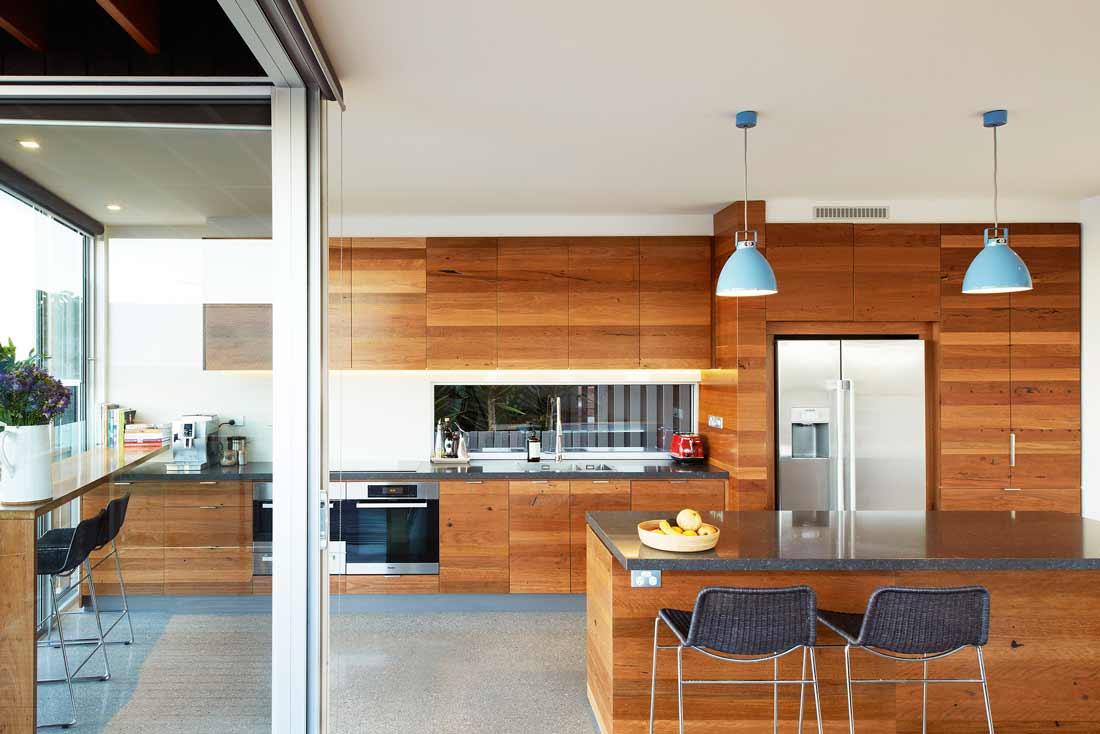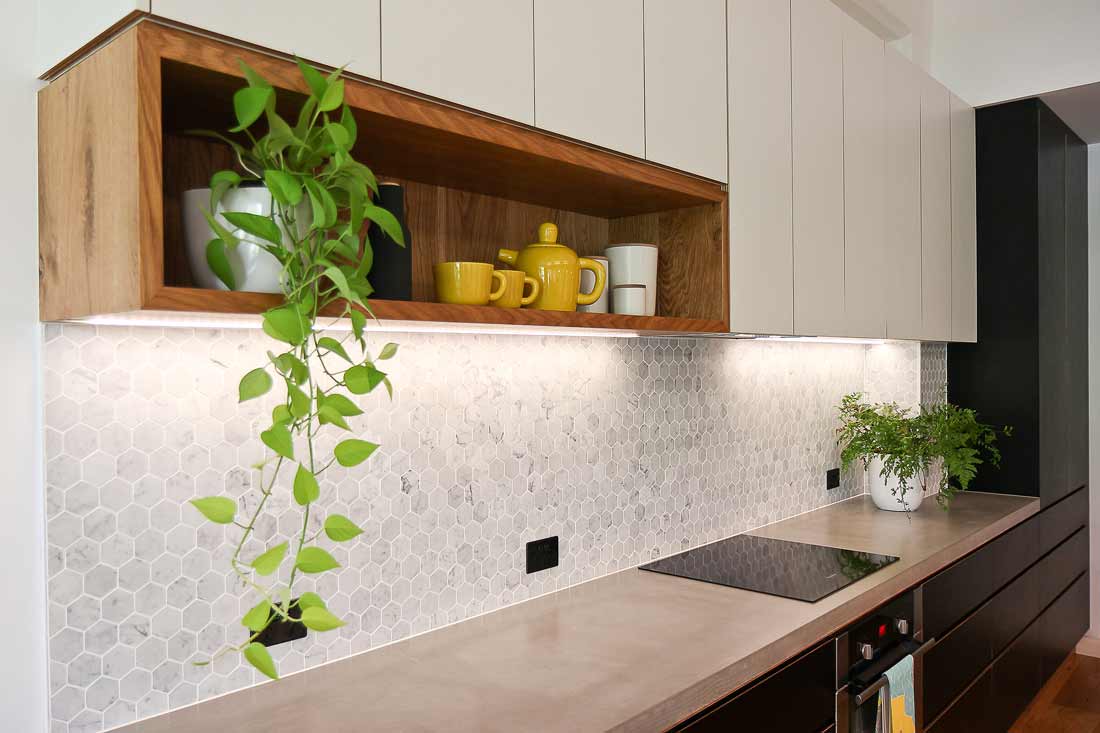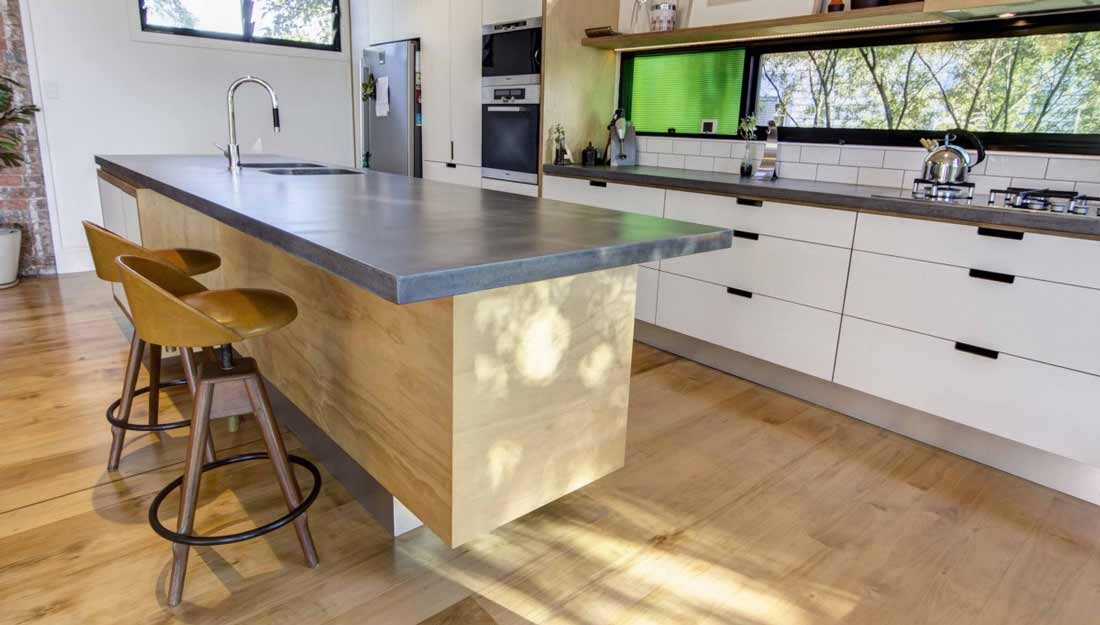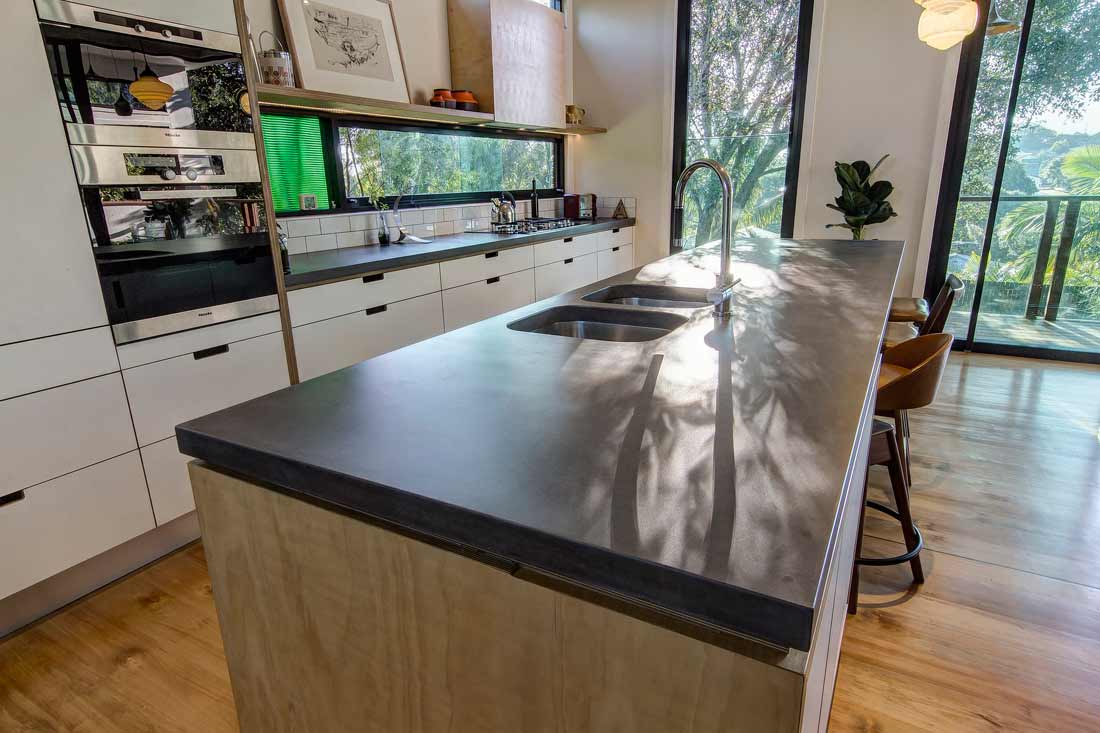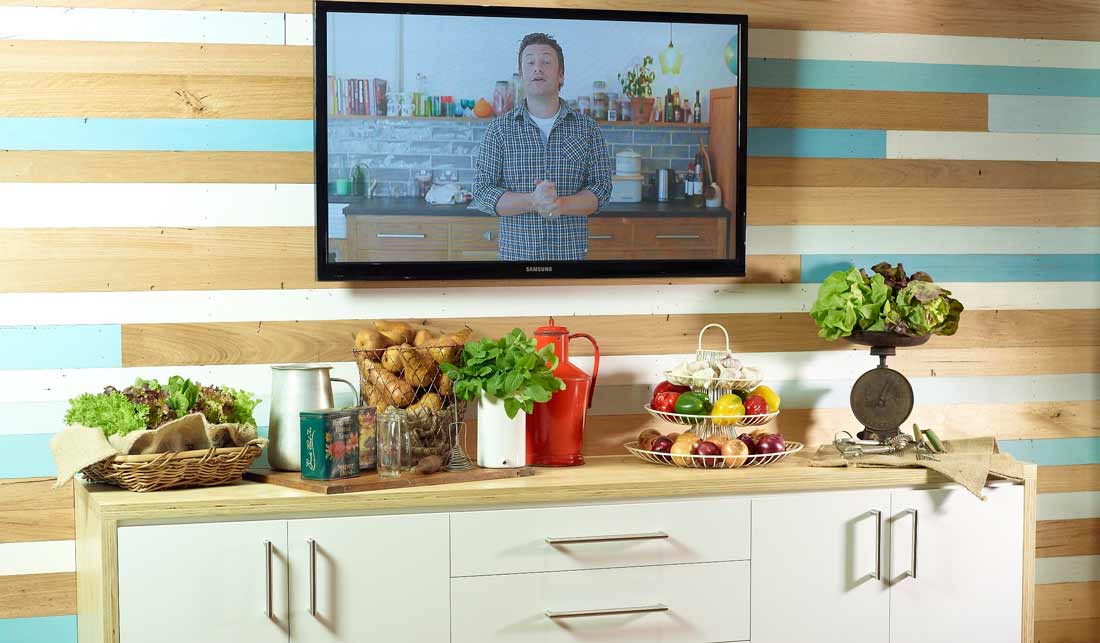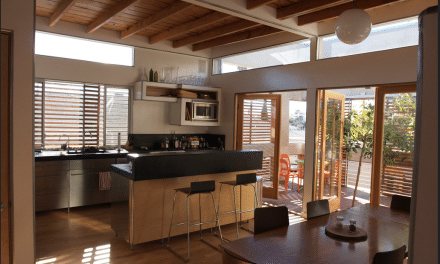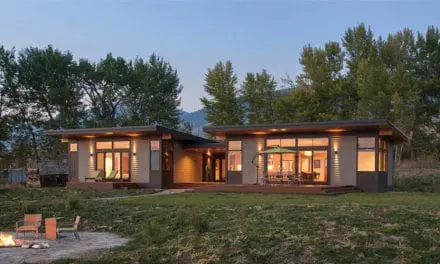This article was written by and originally appeared on the Undercover Architect.
I first discovered Greener Kitchens when I was researching and pulling together some material for Alexx Stuart’s Low Tox Life Community.
Before I started my research, I knew a little about some of the hidden things that live in the materials that most garden-variety kitchens are constructed from.
Most joinery is laminated “HMR MDF” – which is High Moisture Resistant Medium Density Fibreboard. MDF is a wood product where wood is shredded to a cotton-wool like form, and then processed into boards by adding resin, and other things based on its use. So HMR MDF has some water-resistant resin added. In most kitchens, it’s then laminated with a finish, or has a “2-pac” finish.
Laminate, such as Laminex, is thin sheets of paper, layered on the MDF – again using resins to adhere and provide the protective finish.
And 2-pac is a 2-part paint system … again with resins, acrylic paint and melamine. It’s basically a hardener mixed with a paint, and they react with each other when mixed to create the finish they do.
Technology and material development have come a long way, and certainly improved the environment quality of some of these materials. However, there’s still issues … for example, the hardener in 2-pac contains isocyanate, a toxic chemical, that can cause issues for the painters applying it. Formaldehyde can cause skin and respiratory issues (amongst other things), and is considered a carcinogen by some medical bodies (you can read more about it here). Australian Standards legislate its use in building materials, however unless you specify it, you usually don’t get the lowest level in your product.
What, though, if you just want to avoid it altogether? Is that possible? Well, that’s why I wanted to speak to Druce Davey, the owner of Greener Kitchens, to understand more about how they create kitchens that are sustainable – for our health and well-being, and the planet.
Greener Kitchens design kitchens, bathrooms and other spaces, with you and the environment in mind. They do this through Queensland, New South Wales and Victoria. They are also the selected designers for Jamie Oliver’s Ministry of Food Centres and Trucks through Queensland, New South Wales and Victoria.
They’ve received awards for their work, and lots of great press coverage too. I think you’ll really love what Druce has to share in this interview, and be inspired by their gorgeous projects I’ll share here.
Druce – please tell us a bit about you, and how Greener Kitchens came into being …
I started my design career with studies in set design, then pretty much fell into Interior Design about 15 years ago, specialising in joinery (because I was the only one game (or crazy) enough to take it on).
I was then lucky to work for a lovely old fashioned kitchen firm for six years, with the workshop downstairs, giving me a great opportunity to learn how things come together and have a tinker myself.
After a while I started to think about the materials we were using, just as the industry was being flooded by cheaper imports, and got a bit of a shock to discover the lack of accountability for where things were coming from, what was in them and the potential health implications from exposure to them.
I also discovered there were a few materials (not many back then) that were much healthier and kinder to the environment and that was the start of Greener Kitchens, now 7 years ago.
Boy that time has flown! I started Greener Kitchens as a cheeky little quiet protest against an industry that was increasingly looking like it was all about style over substance, cost over caring and materials designed to last just as long as they stay ‘on trend’.
I hoped I could offer an opportunity for people to connect to their kitchens practically, emotionally and ethically. After hundreds of projects now, I hope we have proved a ‘greener’ kitchen is possible.
How do you define ‘greener’ or ‘sustainability’ when it comes to kitchens and bathrooms (and homes generally)
Being ‘greener’ certainly doesn’t mean it looks like it belongs to Grizzly Adams, which isn’t that cool unless you live in the mountains and have a pet bear (UA note – I LOVED that TV show!!).
To me ‘greener’ encompasses a wide range of ideas, and priorities, but distills down to knowing where materials come from, what they are made of, how long they will last for the purpose you are intending and where they will end up once you are finished with them.
Asking these questions informs prudent choices, no matter what the budget. ‘Greener’ kitchens are long lasting, suitable for purpose, sensitively designed to be very functional, timeless, low emission and made using verifiably environmentally responsible manufacturing processes and materials.
This makes for a kitchen that is loved by the occupants, that they have pride in, the heart of their home for decades.
Kitchens made from materials that come from who knows where, made from who knows what, that last just long enough to be out of style and thrown into landfill, are the stuff of nightmares to me, belonging to a throwaway world responsible for misusing our precious resources and doing wrong by all we share the planet with.
It is about creating something real and loved and treasured, that connects ethics to aesthetics.
This is a Brisbane kitchen, that uses joinery made from super robust laminated plywood and oak floorboards (both of which are Chain of Custody certified, of course) teamed up with concrete benches. (Concrete is a great choice compared to sheet materials such as stone and laminate, due to the low waste – no ‘off-cuts’ here!)
What do most homeowners not know about the average, domestic kitchen or bathroom build or renovation, in terms of impact on their health and well-being (and the environment)
Kitchens are made of wood, lots of it. Most of your kitchen started as a tree. After your framing and your flooring the kitchen is the largest amount of wood product in your home. It might not look like it when it’s compressed into MDF with a melamine face or covered in paint or wrapped in stainless steel, but most of your kitchen started as a tree, so it is important to make sure you know where that tree came from. You know where it comes from if you choose recycled or Chain of Custody Certified wood for your kitchen.
Recycled timber is easy to spot. It has had a previous life so it has nail holes, nicks, joist shadows and all those awesome character marks that come from a life well lived. Ask where it came from and be prepared for a beguiling backstory. Over the years I have designed old shearer’s benches, church floorboards, bridges, roof trusses, decommissioned power poles into our kitchens. Recycled timber in a kitchen is genius, it is responsible, robust and long lasting, it tells a story, it breaks the ice at parties, and it saves the trees. Recycled timber is perfect for kitchen doors, benches, shelving and cladding.
Chain of Custody Certified wood products have a logo on them. Not a dodgy botched up logo created in a marketing laboratory by cheeky greenwashers, but a trustable ridgy didge logo that means the timber has come from responsible forestry practices, and has not been substituted in the process of presenting it to you for purchase.
The authentic logo of a Chain of Custody Certification scheme means everyone who touches it from the forest to the shelf is certified and regularly audited to ensure they are compliant. If it does not have a Chain of Custody Certification scheme logo on it don’t buy it, or better still ask the store manager or designer why they don’t have any Chain of Custody Certified timber products. They will likely give you a story about the logos being a waste of time and hippy dippy rubbish but I promise you they are not.
They are your only way of knowing for sure that your purchase protects forests and the habitats, waterways and the species that rely on them, including us, preserving them for future generations. It is your only way of knowing with complete confidence that you are not contributing to the destruction of the world’s valuable forests by ordering a new kitchen. Truly.
The Chain of Custody Logos you are looking for are the FSC (Forest Stewardship Council) Logo and the PEFC (Program for the Endorsement of Forest Certification) logo. There are Chain of Custody certified materials available for kitchen carcasses, doors, and benchtops, in fact all of our Greener kitchens are made using only Chain of Custody Certified or recycled timber materials. I like to say if it is from a tree, make it FSC.
This is a great passion of mine and something I have been banging on about for years as the Ambassador for the Planet Ark ‘Make It Wood’ Campaign, which has given me an awesome little voice for this important message.
The materials your kitchen is made from contain Volatile Organic Compounds (VOCs) that emit nasties into your home. The main culprit in the kitchen is formaldehyde that is present in typical kitchen materials and paint finishes. Much lower safe levels of the off-gassing of VOCs in your kitchen can be assured by demanding the use of low VOC materials such as E0 or Super E0 board materials and low or no emission paint finishes.
These exist, are fit for purpose, reasonably priced and are readily available. Unfortunately, they are unlikely to be used unless you request them.
What mistakes do you see homeowners making when it comes to renovating and building their homes – especially with the kitchen and bathroom in mind?
I think the biggest mistake homeowners make, after not worrying about where materials come from and how well they will last, is to not put enough of themselves into their home.
The best spaces are not a copy of a Pinterest picture or a magazine shoot or imposed upon you by a designer or architect.
Sure a designer or architect should provide invaluable inspiration, advice and pointers, but they need to be filtered through you and what you know you love and need.
This creates spaces that work and have soul, you can literally feel the warmth and joy in them. It is about creating something real, that brings families together and might even be passed on rather than discarded.
Another Brisbane kitchen, the design here was inspired by the client’s vintage stools and lighting, handed down to them by grandparents who received them as wedding gifts fifty years ago.
To ensure the kitchen would be low emission, environmentally responsible, robust and long lasting, it was made from Chain of Custody Certified plywoods, including the carcasses, with concrete bench-tops, all finished with low emission sealants.
What are 3 simple choices a homeowner can focus on to make a big difference when renovating or building their kitchen or bathroom (or any space in their home)?
- Take time to consider, really consider, how a new space will work for YOU
- Care about where your materials come and try your best to make them as responsible, healthy and long lasting as possible
- Work with people you click with and have fun
(UA note: Couldn’t have said it better myself, Druce!)
Homeowners often hear ‘green’ and think it will come at a cost premium – is that always the case? (Can these choices cost the same, or save money long term in maintenance and use, for example).
‘Green’ materials are not necessarily more expensive. There are materials that are more responsible that cost less than ‘name’ brands, while maintaining equal or better quality. It is a shame more people do not know about them!!
A more responsible kitchen takes more thought, care and consideration, not necessarily more money. There are better choices for every budget.
How did you get involved in Jamie Oliver’s Ministry of Food Kitchen Centres and Trucks? What has been your role there?
What I am doing with Greener kitchens was recognised as a good match to the values, philosophy and ‘look’ for Jamie’s awesome Ministry of Food program in Australia (that was a phone call I’ll never forget!), so I was asked to create healthy kitchen classrooms for the program to teach healthy cooking from scratch in.
As a result I have designed six kitchens for Jamie in three states, two of which are in the back of trucks, that are made from super low emission and environmentally responsible materials, including a lot of rescued, reused and recycled elements. Embracing recycled materials has really helped make the spaces warm and welcoming and connect them to the communities they are serving.
For instance the timber island bench-top in the Ipswich Ministry of Food Centre is made from decommissioned power poles from the local area and I actually had to be rescued from a huge skip bin I had dived into for some floor boards from an old Queenslander that was being demolished that we used for cladding. So it’s not just the food that is locally sourced!
Designing for Jamie is awesome fun, a challenge and a great privilege, and to have a little tiny part in his crusade to make peoples lives better through food is something I am very proud of.
Where can people find you, and where do you work?
I work with clients in Brisbane, Sydney and Melbourne as well as Byron and Noosa and surrounds, and the best way to contact me is by email at druce@greenerkitchens.com.au
Here’s Druce’s details again if you’d like to get in touch with him about your kitchen, bathroom or another space in your home:
Greener Kitchens
Click here for the website, and see more about these projects, as well as more info about Greener Kitchens.
Email Druce on druce@greenerkitchens.com.au and tell him you found out about him at Undercover Architect!
All images are sourced from Greener Kitchen’s website with permission.
This is NOT a sponsored post – We just love sharing helpful info about awesome people and businesses.


